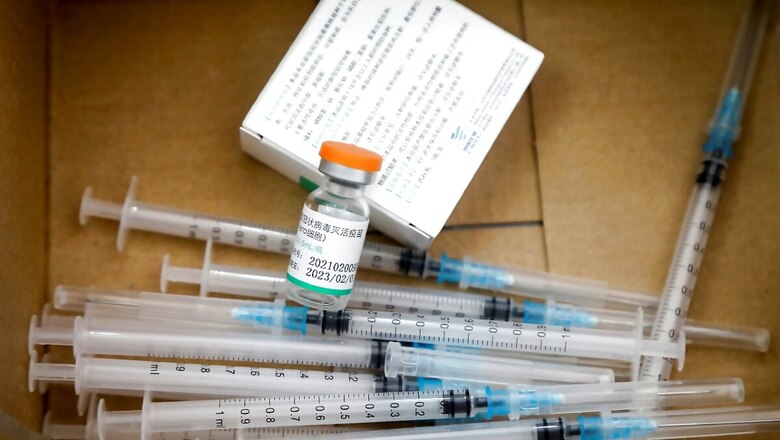
views
In times of a global pandemic that has ravaged all countries, even the advanced economies, to talk of vaccine diplomacy seems abnormal. Using vaccines as a diplomatic tool to gain political influence in countries and serve geopolitical ends in a crisis situation such as this where all are vulnerable, whether allies or adversaries, is a disservice to humanity and to our collective existence. The gap between human rights and other universal values that are espoused and the lack of true human solidarity when havoc has been wreaked on societies everywhere by COVID-19 is manifest.
At one level, it is perfectly understandable that the first responsibility of governments is to protect their own people. Beyond that is the role of the big pharmaceutical companies whose priorities are elsewhere, in protecting intellectual property and profit margins. The ‘Big Pharma’ lobby is extremely powerful and influences governmental decisions. This is evident from the diplomacy around the India-South Africa proposal at the WTO on the temporary suspension of TRIPS (Trade-Related Aspects of Intellectual Property Rights) on patents and other therapeutics for the manufacture of vaccines and medical treatment. The US has extended support for suspension of TRIPS for anti-COVID vaccines only and not for the ingredients that go into their manufacture and therapeutics. The European Union does not support the India-South Africa proposal. It believes that the solution lies instead in licensing arrangements with manufacturers so that vaccine production can be ramped up in various countries as well as liberalisation of exports—a veiled criticism of the US hoarding of vaccines and its export ban. The Big Pharma opposes any suspension of patent rights.
External Affairs Minister S. Jaishankar during his recent visit to the US rightly made the point that the solution to the pandemic has to be global, with people across continents having access to vaccines at affordable cost, and that if some parts of the world are protected and others neglected, the world will remain vulnerable. With the mutations that are occurring, this danger is real. His hope was to persuade the US government to lift the priority ratings under the Defense Production Act and strengthen the supply chains for AstraZeneca and Novavax by impressing upon the producers of the vaccine ingredients to ramp up production for supplies to India so that we can produce the massive volumes we require for our own vaccine programme. In short, our diplomacy is focused on securing the vaccine supply chains by easing their regulatory disruptions and easing exports of vaccine ingredients and components to India.
The Domestic Challenge
The geopolitical aspect of the US and India joining hands to counter China’s vaccine diplomacy faces some hard realities. The US’s own hoard of 80 million vaccines is totally insufficient to meet global needs, even if all were available for others. For the moment, the US has announced gifting of 25 million doses, 19 million for the Covax facility for developing countries and six million for 13 high priority countries including India, although the US coordinator for vaccines has stated that India will receive substantial numbers based on our immunisation plans and cold chain capabilities to ensure they can be utilised. If just the Asian recipients under Covax are 16 countries, it would seem India could receive about 2 to 3 million doses when India’s daily vaccination rate is around 2.13 million! If India were to vaccinate its entire adult population by the end of December 2021, we need to produce 238 million doses every month from June onwards. Before we can think of seriously countering China’s vaccine diplomacy globally, we need to first address the massive challenge we face at home.
The debate in India around the export of vaccines at the cost of our own people has become very heated politically, and given the scenario of vaccinating not only our adult population but also those below 18, and the involvement of the courts in this area, the scope of India’s vaccine “diplomacy” that began on a high political and humanitarian note has shrunk. India has had to ban the export of vaccines, leading to the failure of Indian companies like the Serum Institute of India to honour already signed commercial supply contracts. Some of our neighbouring countries who were hoping for additional supplies from us, and have reached out to us even now, such as Bangladesh, have had to turn to China. With the WHO approving the emergency use of two Chinese vaccines—Sinopharm and Sinovac—China’s use of vaccine diplomacy for geopolitical ends has been facilitated. The approvals open the way for these vaccines to be used for the Covax facility, led amongst others by the WHO, alongside UNICEF as key delivery partner. Whether public confidence will be an issue in ready acceptance of Chinese vaccines because of serious doubts about their efficiency remains a question.
The Global Challenge
Time is of the essence in view of the new waves of the pandemic that countries are facing. The second wave in India has been particularly vicious. The UK and France have experienced this wave and Japan is in the throes of it currently. The international community is not organised enough to deal with the severe challenge facing it. The India-South Africa initiative at the WTO will require extensive text-based negotiations which, even if they succeed, will take time. More so, as the US and the EU will have to reach a consensus.
An unanswered question is the advantage that China could take of patent waivers to get into the international game even more strongly. The BRICS meeting at the Foreign Minister level on June 1 has backed vaccine patent waivers, sharing of doses, transfer of technology and development of vaccine production capacities and equitable access to vaccines, diagnostics, and essential health products, technology and components. The G7 Health Ministers in a meeting on June 3 and 4 have agreed to tackle future health threats together and share vaccines with poorer countries. The G7 summit to be held in a few days in the UK will discuss the pandemic, and India as an invitee will be participating in it virtually and Prime Minister Narendra Modi will no doubt make our views known on the pressing need for greater international cooperation to combat the pandemic. As China is not part of G7, any strategy worked out will be independent of its ambitions.
In short, the scale and dimension of India’s own needs and the lack of clarity on how far the US government and its pharmaceutical sector—which has long standing grouses against India on India’s patent laws that have made it a powerhouse for production of generics—would be willing to join hands with India to meet global needs do not provide an easy answer to the issue of China using vaccines as a diplomatic card to position itself still more favourably in the developing world.
Read all the Latest News, Breaking News and Coronavirus News here.



















Comments
0 comment